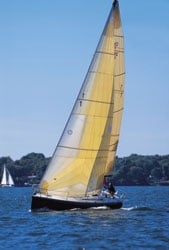
C01BOTY11.jpg
Lets look now at a category of six boats from 34 to 40 feet that are optimized for speed: bendy rigs, slippery foils below the waterline, and weights kept low–in both senses of the term. Each of these boats delivers a thrill to those who are drawn to the pure, adrenaline-drenched joy of sailing. The 34-foot LS-10, built by Soca Yachts in Trinidad, is designed to race in the Tartan 10 class. The Beneteau First 36.7, built in France but about to go into production in South Carolina, is a design collaboration between Bruce Farr and Beneteaus in-house guru, François Chalain. The C&C; 99 is a Tim Jackett-designed 34-footer built in Ohio by Fairport Yachts, which also builds Tartans. The German-built Dehler 36 is designed by Judel & Vrolijk, a team known for its Admirals Cup successes. The Cape Fear 38, designed by Bruce Marek, is being built by a new boatbuilding consortium in North Carolina. And, finally, the Farr 395 One-Design is designed by Bruce Farr and is being built by Carroll Marine in Rhode Island.
Of these, the C&C; 99 stood out for the excellent value it offers at $120,000 together with its blend of sailing performance and simple cruising amenities done well. “Its small enough, quick to get under way, and easy to handle with working sails,” said Ralph. “Her deck is laid out by a sailor who has performance in mind, and theres nothing wrong with performance in a cruising context.”
Ralph was impressed by the C&C;s structure. “This is an epoxy-laminate boat–the best resin possible. And for a production boat, this one showed some excellent engineering,” he said, referring to, among other things, the tie-rods that anchor the chainplates.
The two-cabin interior was simple but functional. “I like the finish, the woodwork, the design of everything down below,” said Carol.
Under sail, the boat really came alive. In 10- to 12-knot conditions during our trial, we had boatspeeds of 6.8 to 7.2 knots.
“I loved sailing this boat,” said Carol. “I loved how stable it was, and how much sail we could carry.” Alvah agreed: “The boat was stiff. Nobody hesitated when they said, Weve got a kite. Wanna put it up? The boat felt safe and good.”
Systems were above average but not at the top of the fleet.
“Jackett does the electrical panel well, with big conduits for the wiring,” said Skip, although for safety he would prefer to have seen a separation between the alternating-current (AC) side of the panel and the direct-current (DC) side.
He found the sound insulation around the engine rather thin, which accounted for some of the loudest running noise in the fleet: 96 dB with the Volvo pushing us at 7.2 knots.
“The cockpit was relatively cruiser friendly,” said Alvah. Skip concurred: “When youre finished with a day of racing, you can actually sit in this cockpit and relax. Youve got a backrest. The ergonomic style is really good.”
“This is a boat that fits the schedule, needs, and pocketbook of a majority of sailors,” said Ralph.








